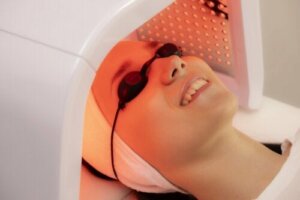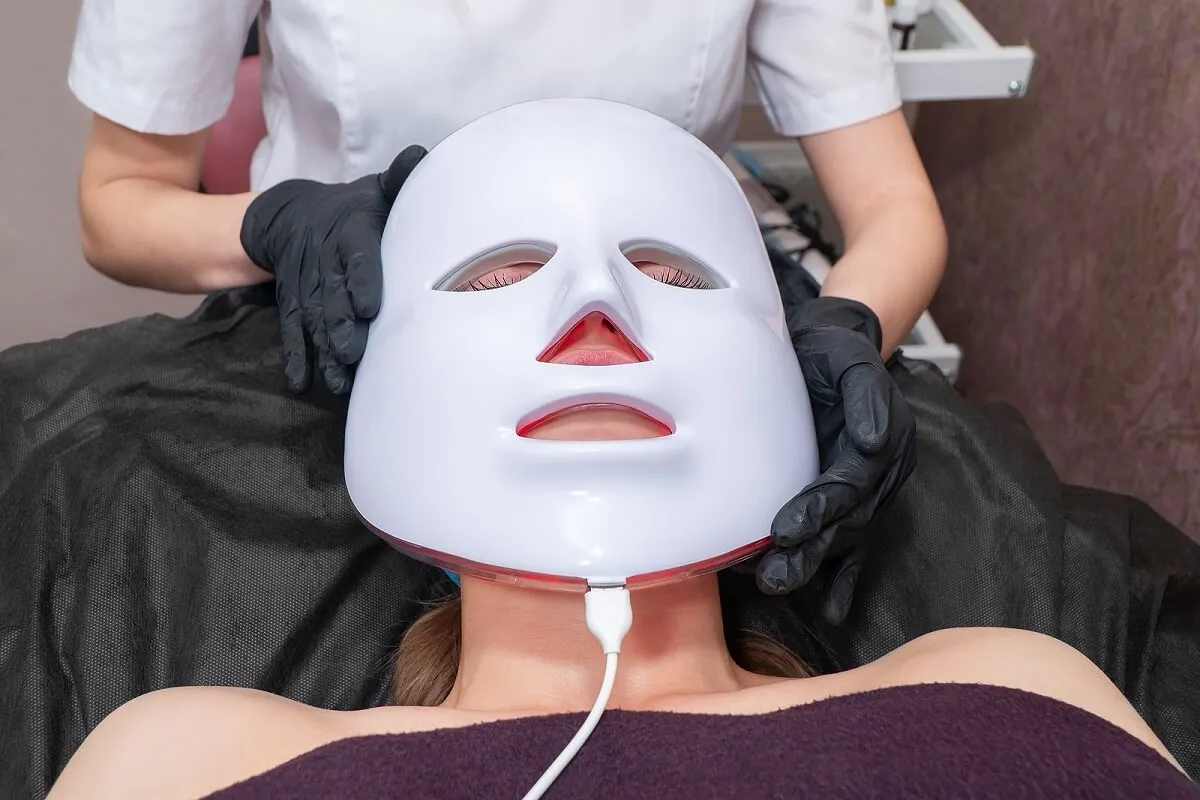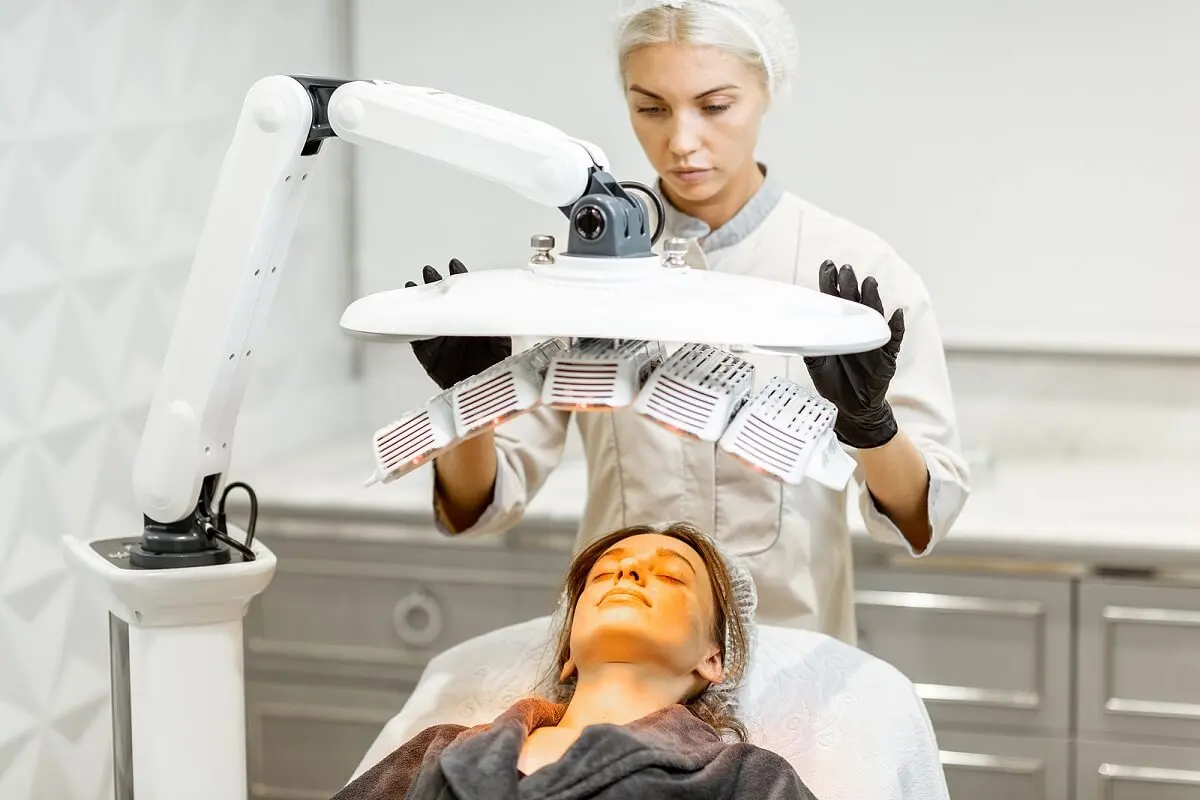LED Phototherapy: Uses, Benefits and Care

LED phototherapy is a cosmetic technique that is applied to improve the texture and appearance of the skin. It consists of exposing the desired area to a “cold light” in order to activate the photoreceptors and generate a series of biological responses.
This technique is also known as “light therapy”, “chromotherapy”, or “bioluminescent therapy”; and although it’s usually used as a facial treatment, it also has the potential to be applied to any part of the body. In general, it’s a non-invasive, painless, and safe procedure. Would you like to know more about it?
What is LED phototherapy?
LED phototherapy uses the technology known as Light Emitting Diode (LED). For its application, an area of the skin is exposed to a cold light by means of a laser. This light can be of different colors and, in turn, each one generates a different effect.
To be more precise, the technique uses light-emitting diodes that release light that stimulates metabolism and cell growth. This leads to an increase in the production of collagen and elastin, two elements that have a major impact on the health and appearance of the skin.
Generally speaking, people use this treatment to combat the signs of aging, hyperpigmentation, and acne. And while, until recently, only its effect on acne has been studied, there’s now evidence of its potential against blemishes and wrinkles.

Another great article: Activated Carbon Laser Peel: Process and Care
How does LED phototherapy work?
This type of phototherapy doesn’t use ultraviolet light. Instead, it uses a low-level light that is safe for the skin. This is produced in different wavelengths and colors that are projected onto the desired area through lamps.
Sometimes, the light exposure is combined with a photosensitive drug that’s applied to the skin, known as “5-aminolevulinic acid”. Its function is to sensitize the treatment area. The effect achieved depends on the color of light used, as we’ll see below.
Red light
This infrared light is used to treat the epidermis, which is the most superficial area of the skin. The aim is to absorb and then stimulate the collagen proteins.
This results in the reduction of fine lines and wrinkles. It also reduces inflammation and improves circulation, making the skin brighter.
Blue light
Blue LED light is used to reduce the activity of the sebaceous glands. These are located under the hair follicles and provide lubrication to the skin and hair.
When they become overactive, they can cause excess oil production or acne. This light also helps to kill bacteria under the skin.
Yellow light
The yellow LED light has an anti-inflammatory effect and can penetrate deeper into the skin. Incidentally, it stimulates circulation. It’s recommended for cases of irritation and redness, rosacea, and all conditions that cause heat or stinging of the skin.
Green light
This type of light is particularly indicated for cases of melasma and other pigmentation problems. Due to its action, it decreases the production of melanin and, therefore, attenuates dark spots. A study published in 2018 highlights the efficacy of this light for the management of melasma.
Other
Newer LED light therapy devices include three other colors. These are as follows:
- Violet light. Combines the properties of red and blue light. It has a soothing and healing effect. It’s recommended for marks left by acne.
- Light blue light. Improves the skin’s metabolism and has a calming, relaxing, and energizing effect. Recommended for sensitive skin.
- White light. It has a regenerative and anti-flaccidity effect. It tones the skin and is indicated for aged or cracked skin.
Why not take a look at this? Myths and Truths of Laser Hair Removal
What does the LED light therapy procedure look like?
Each LED light therapy session lasts about 20 minutes. It usually takes about 10 sessions to get visible results. This procedure is almost always performed in a dermatologist’s clinic, but there are also at-home devices that are commonly used.
Facial devices for performing LED light therapy at home include the following:
- Light facial masks
- Ultrasonic devices
- Light wands to treat specific blemishes
- Mesotherapy electroporation devices
- Professional LED light machines
The principle behind LED phototherapy is the fact that the skin uses light as an energy source to promote the repair or rejuvenation of damaged cells. The light accelerates tissue repair, while having the potential to kill bacteria.
Benefits and advantages of LED phototherapy
LED phototherapy helps to combat acne and aging. It also promotes healing processes in the skin, corrects skin tone, and generally improves the appearance of the skin. It also provides more firmness, uniformity, and luminosity.
Other outstanding benefits of this type of therapy are the following:
- Attenuates spots and delays their appearance
- Reduces skin wounds
- Promotes nail and hair growth
- Slows down the aging process
- Helps in the elimination of bacteria that cause skin damage
- Improves acne scars
- Improves cell metabolism
- Contributes to the treatment of stretch marks
- Reduces inflammation and erythema caused by more aggressive treatments
Advantages
- It’s a non-invasive treatment.
- It doesn’t produce burns, discomfort, or pain.
- It doesn’t require special care after its application.
- It adapts to all skin types.
- It’s compatible with other skin treatments.
- It can be applied in summer, without any problem.
- It’s suitable for pregnant women.
- It’s useful for a wide range of dermatological problems.
- It doesn‘t use ultraviolet rays.

Risks and side effects
LED phototherapy isn’t without its controversies, particularly the use and safety of home devices. In particular, a home-use mask launched some time ago caused eye problems in users. It was subsequently withdrawn from the market.
There are a number of research studies that support the efficacy of LED light therapy. However, they clarify that the right light must be applied in the right way to achieve the desired effect.
Many home devices on the market don’t guarantee either the right light or the right application. Therefore, they can’t be considered safe from a technical point of view. In this sense, only procedures applied by a professional can be endorsed.
It isn’t common for LED light therapy to cause side effects. However, in some cases, it can cause mild effects such as itching, redness, dryness, and swelling. This is more common when photosensitizing medications are used.
Tips and recommendations
Some medications increase sensitivity to light. This is the case with some antibiotics used to treat acne, such as isotretinoin. If these drugs are being used, then LED phototherapy shouldn’t be applied.
It’s very important for the eyes to be properly protected during treatment. This recommendation applies especially in cases where home devices are used. Such devices can cause damage to the eyes.
Neither is it advisable to use this treatment when the person has an active rash. People with psoriasis should always consult a doctor before using LED light therapy.
Final recommendations
Although some results may be noticeable after the first LED light therapy session, significant changes are usually only seen after the treatment is complete. It’s important to keep in mind that the results aren’t permanent.
Therefore, it’s advisable to repeat its use periodically to prevent the recurrence of the problems you want to eliminate. Once each session is finished, the recommendation is to avoid sun exposure for 48 hours. In addition, it’s essential to apply sunscreen.
All cited sources were thoroughly reviewed by our team to ensure their quality, reliability, currency, and validity. The bibliography of this article was considered reliable and of academic or scientific accuracy.
- Ablon G. Phototherapy with Light Emitting Diodes: Treating a Broad Range of Medical and Aesthetic Conditions in Dermatology. J Clin Aesthet Dermatol. 2018;11(2):21-27.
- Mpofana N, Abrahamse H. The Management of Melasma on Skin Types V and VI Using Light Emitting Diode Treatment. Photomed Laser Surg. 2018 Oct;36(10):522-529. doi: 10.1089/pho.2018.4486. Epub 2018 Sep 18. PMID: 30227084.
- Opel DR, Hagstrom E, Pace AK, et al. Light-emitting Diodes: A Brief Review and Clinical Experience. J Clin Aesthet Dermatol. 2015;8(6):36-44.
- Pei, S., Inamadar, A. C., Adya, K. A., & Tsoukas, M. M. (2015). Light-based therapies in acne treatment. Indian dermatology online journal, 6(3), 145–157. https://doi.org/10.4103/2229-5178.156379.
-
Lee SY, You CE, Park MY. Blue and red light combination LED phototherapy for acne vulgaris in patients with skin phototype IV. Lasers Surg Med. 2007 Feb;39(2):180-8. doi: 10.1002/lsm.20412. PMID: 17111415.
- Ellizca Medrano, K. B. (2017). Eficacia de la fototerapia Led comparado con la fototerapia convencional para acelerar la reducción de los niveles de bilirrubina en neonatos con ictericia.
This text is provided for informational purposes only and does not replace consultation with a professional. If in doubt, consult your specialist.








